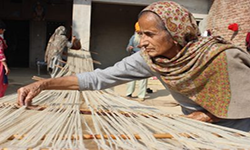
Advocacy, Case Studies, Craftspersons/ Artisanal, Employment/ Livelihood
TRINJAN – A Women’s Cotton Collective
Garg, Rupsi
Issue 10,Summer 2023
Issue #10, 2023 ISSN: 2581- 9410
I embarked on my self-exploration journey at Azim Premji University in Bangalore in 2016. While juggling between my routine academic and hostel life, I immersed myself in extensive reading of diverse subjects and topics alongside the coursework. At this time, I came across the book 'Gram Swaraj' by M.K. Gandhi, which refreshingly opened my perspective on the functioning of Indian villages and emphasized the importance of traditional household components like the charkha and handloom for clothing needs; inspired by this ideology as well as other books on Punjab's environment, I developed a strong association with the concept and eventually joined KVM (Kheti Virasat Mission) in 2018 after completing the masters.
After familiarizing myself with the KVM’s methods and village practices, I got engaged in discussions with fellow organic farming enthusiasts in Punjab's Malwa region, and conducted a comprehensive survey on various factors related to cotton cultivation in Punjab, including geography, history, ecology, environment, culture, and social aspects. In 2002, KVM-affiliated farmers campaigned against Bt cotton, a genetically modified pest-resistant variety. After cultivating cotton organically for 15-20 years without significant commercial focus, mostly the cotton collected after farming was either sold directly in mandi (grain...
This is a preview. To access all the essays on the Global InCH Journal a modest subscription cost is being levied to cover costs of hosting, editing, peer reviewing etc. To subscribe, Click Here.
ALSO SEE
Chatterjee, Ashoke



